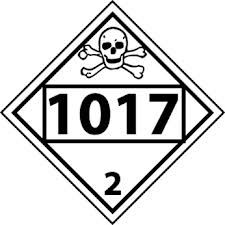![]()
![]()
![]()
Use LEFT and RIGHT arrow keys to navigate between flashcards;
Use UP and DOWN arrow keys to flip the card;
H to show hint;
A reads text to speech;
20 Cards in this Set
- Front
- Back
|
Cl |
Chlorine Atomic number 17 Halogen group |
|
|
Cl Specific Gravity |
1.41 |
|
|
Cl Vapor Density (air=1) |
2.49 |
|
|
Cl expansion ratio |
457.6 |
|
|
Cl Health Effects 0.5ppm |
No Signs or symptoms |
|
|
Cl Health Effects 3-8ppm |
Discomfort, stinging, and burning eyes |
|
|
Cl Health Effects 50-250ppm |
Severely irritating to the eyes and mucous membranes; coughing, choking, nausea, dizziness, headache, and difficulty breathing |
|
|
Cl Health Effects 250-500ppm for 3 min |
Delayed pulmonary edema |
|
|
Cl Health Effects 1000ppm (a few breaths) |
Death |
|
|
Cl Monitors |
Ph paper EC-P2 0-100ppm (0.1ppm resolution)HC |
|
|
Cl Primary Hazard |
Inhalation Toxicity |
|
|
Cl Physical Properties |
yellow-green gas 2.5x heavier than air highly poisonous acts as an oxidizer Odor @ 0.08ppm pungent irritating |
|
|
AEGL-1 |
Acute Exposure Guideline Levels is the airborne concentration, expressed as parts per million or milligrams per cubic meter (ppm or mg/m3) of a substance above which it is predicted that the general population, including susceptible individuals, could experience notable discomfort, irritation, or certain asymptomatic nonsensory effects. However, the effects are not disabling and are transient and reversible upon cessation of exposure. |
|
|
AEGL-2 |
is the airborne concentration of a substance above which it is predicted that the general population, including susceptible individuals, could experience irreversible or other serious, long-lasting adverse health effects or an impaired ability to escape.
|
|
|
AEGL-3 |
is the airborne concentration of a substance above which it is predicted that the general population, including susceptible individuals, could experience life-threatening health effects or death. Chlorine @ 50ppm for 10 minutes |
|
|
Chlorine + Water = |
Strong acid HCl (hydrochloric acid) and ClHO (hypochlorous acid) |
|
|
Chlorine DOT placard # |

Chlorineq |
|
|
Chlorine Spill Actions |
EVACUATE civilians to safe distance Cool unruptured vessels Locate leaks and control |
|
|
CHLOREP |
CHLOREP, CHLORine Emergency Plan administered and coordinated by The Chlorine Institute, is a program to provide an organized and effective system for responding to chlorine emergencies in the United States and Canada. It operates on a 24-hour, 7-day-a-week basis with established phone contacts. |
|
|
Chlorine IDLH, TWA |
IDLH 10ppm TWA (NIOSH) 0.5ppm TWA (OSHA) 1.0ppm Odor @ 0.08ppm |

